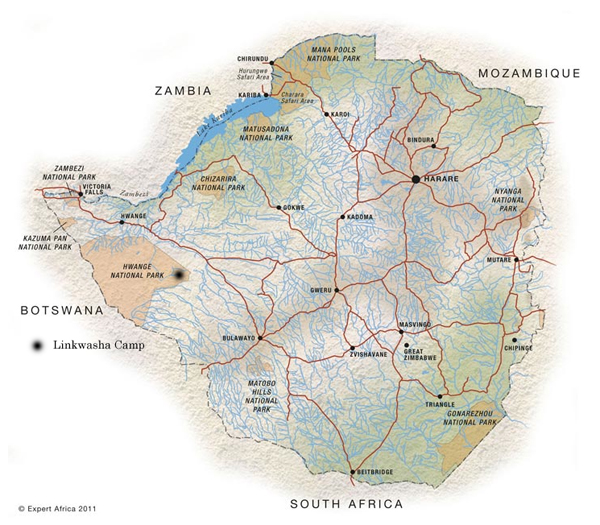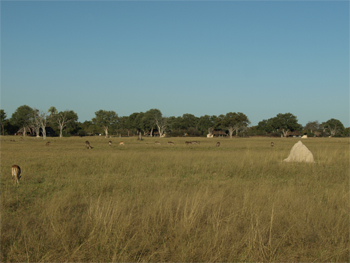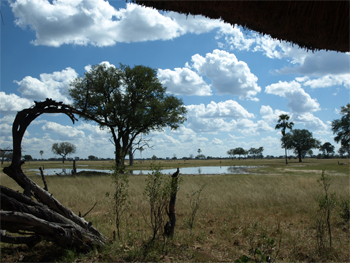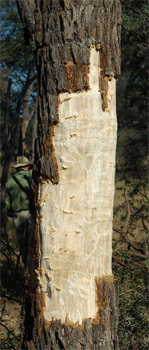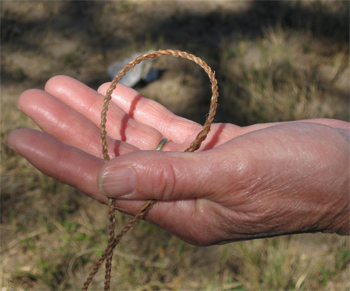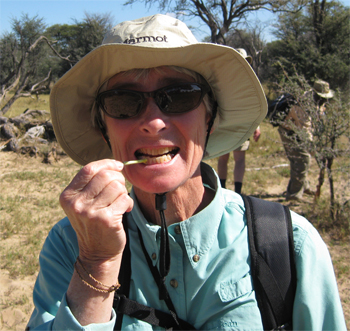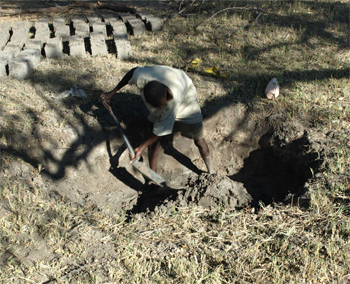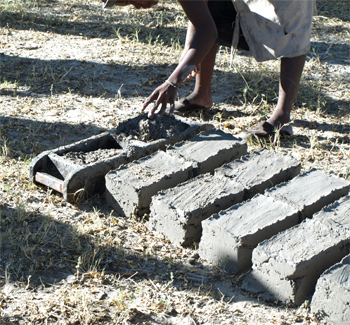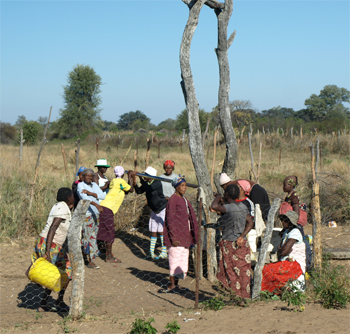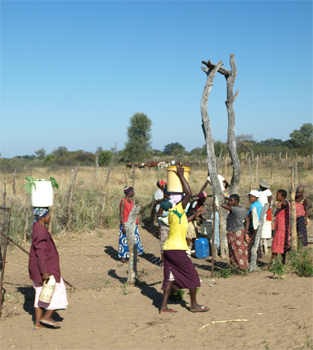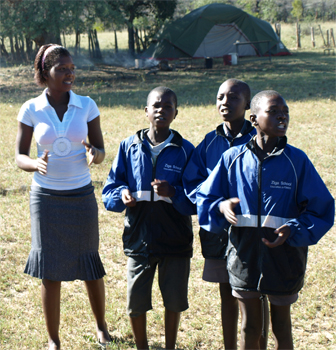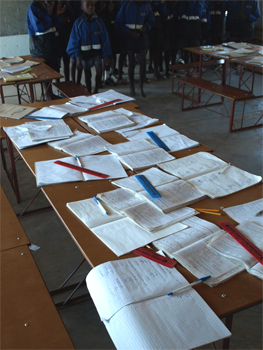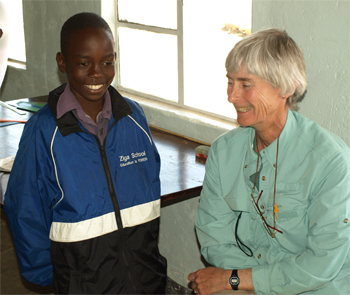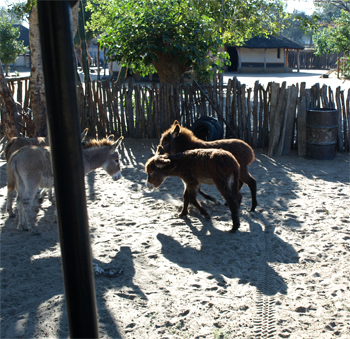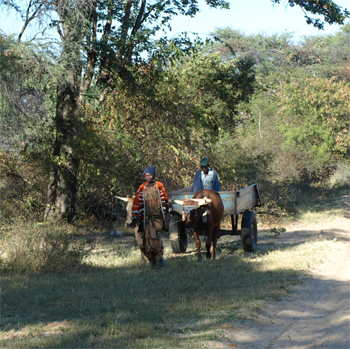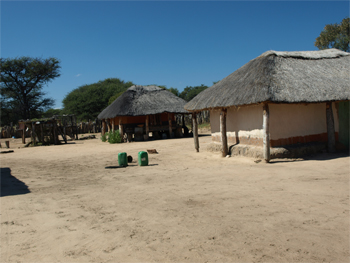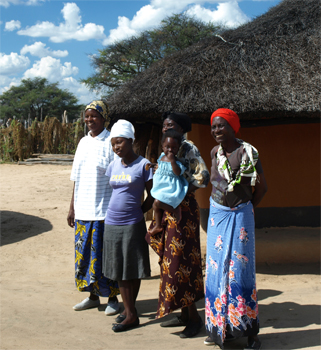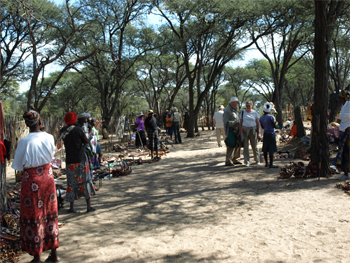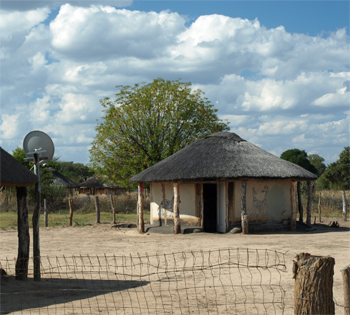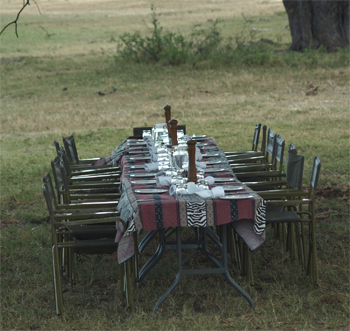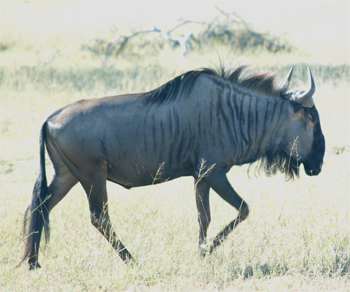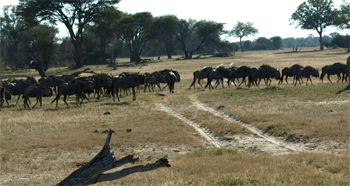May 22 - 25 - Linkwasha Camp, Hwange National Park, Zimbabwe
We got up at 5:45 to pack for our next flight. We flew to Livingstone to exit Zambia - and pay more fees for the privilege of being in this country. We took a bus through Victoria Falls, Zambia and processed through customs. We walked across the bridge at Victoria Falls to take a look at the falls. Since this is the time of high water, all we could see was mist. It is still impressive the way the huge volume of water drops into a gorge out of nowhere. We return to Victoria Falls, Zimbabwe in three days and will see more of it then (pictures then). Back on the bus, we drove to the Victoria Falls airport for our flight to Hwange National Park.
Map of Zimbabwe - Hwange NP and Linkwasha Camp are on the left side
|
|
Flag of Zimbabwe
|
Typical license plate |
We arrived at our new camp, Linkwasha, at 3:30, had a briefing about the lodge and finally had lunch at 4 PM. We are very pleased with our new "tent." It is spacious, neatly decorated, and has a view to die for! From our room, veranda, and outdoor shower (we also have one inside) and the main lodge, we look across a grassland (savannah) with a waterhole and can see elephants, baboons, ostriches, Cape buffalo, waterbucks and zebras. It is incredible!
View of Linkwasha Camp
|
View from our veranda |
On our first game drive after arriving, we drove for about half a mile and found a beautiful, large lion posing beside a termite hill. He was very unconcerned about the 4 safari vehicles full of tourists within 10 yards of him. Eventually, he stood up, paced past our vehicle, had a big stretch, gave several impressive roars, and moved on. Wonderful! |
|
Later in the evening, using the red spotlight, we saw a giant eagle owl and two spring hares. Unfortunately, it was far too dark for pictures.
|
|
The first morning's wildlife experience started with a herd of wildebeests and waterbucks, a jackal, and then a pride of lions trying to make a kill on a group of wildebeests. (Pictures of the hunt.) The male lion sat still, four females got positioned to strike, and another female set the flank. A couple of younger lions (1-2 yr.) finally couldn’t stand the suspense any longer and wandered up to join the crouched, stalking females. If the wildebeests hadn’t seen the lions by then, they surely did now. There were at least four cubs that did not know how to hunt and stayed out of the way. We watched a long time and finally the wildebeests moved into the brush and ran around the lions toward our water hole. Lions do not chase their prey like leopards and cheetahs. They wait and want to strike within 10 meters or less. The wildebeests could see the lions in the short grass, and kept an eye on them and easily avoided them. The lions looked hungry - their ribs were showing. The male was no help. Lions are notoriously poor hunters.
After the hunt, we drove on to a spot to take a nature walk. Our guide, 65 year-old Mafuka, parked in the shade near some woods. In the open area there were elands, zebras, and wildebeests - and several giraffes when we came back. We learned a lot of interesting things on the walk, most of which is reported below.
|
|
Mafuka
|
Elephant damage |
We looked at huge elephant tracks. The front feet make large round depressions and the back feet, oval ones. The distance between the two, shows how fast he was going. Measuring the circumference of the front print and multiplying by two you can judge his height. The one we were "tracking" was about 14 feet at the front shoulder. The dung of the elephant can indicate the sex. If it tastes sweet (yum) it is a female, and salty means a male. Obviously the more moist and warm the dung, the closer the animal might be to your location. Elephant dung is plentiful! and has several local uses. Breathing burning dung will stop a nose bleed and also act as an insect (mosquito and tsetse fly) repellent, boiling it as tea eases labor pains during birth, and baking clay in burning dung fires the clay for pots.
|
|
We finally got an explanation of these termite mounds. The material above ground is made by the worker termites who use saliva, secretion from other termites, sand, and water and deposit it at the surface. It dries hard, like cement. The material can be dug up, formed into bricks and baked in the sun to be used for building houses. There is one queen who lays millions of eggs and some males who attend her. The soldier termites guard her and feed her. It is 32° C inside and fungus grows in and on the mound (actual edible mushrooms appear on top during the rainy season) that is also used for food. The mounds can be 50 meters deep to reach the water table and spread for 10 to 20 meters above ground, which is why grass and trees grow up around them.
|
Termite mound
|
We spotted a mother and baby elephant (or she spotted us). Momma was protecting the young one and made some moves toward us, which is why Mafuka carries a rife on these walks. We got away from them safely.
|
|
Mafuka showed us how they can make rope out of baobab fiber. He made each of the women a bracelet. He also (illegally) creeps up on an elephant or giraffe and pulls out a hair from their tail – or so he says. He makes bracelets from these - they are like wire.
|
Baobab fiber
|
Rolling fiber to make rope
|
Baobab fiber bracelet - one for each of us |
Next we made bush toothbrushes from a bush stem. I brushed my teeth.
|
Bush toothbrush
|
On our evening game drive we saw many more of the same animals. Our guide showed us catfish swimming in some puddles on the road. They are catfish (walking catfish) who can walk from the waterholes to the puddles during the rainy season. At one point, our guide was proving that he could drive through every pot hole (and larger) filled with water, rather than go off the road and around it, and he got us really stuck in the mud. Fortunately, he could radio for help and the other group came to push us out of the hole.
Walking catfish in a mud puddle
|
|
On the way to the "sundowner" stop, we nearly ran over a group of lions sleeping in the road. It was probably the pride from the morning hunt. No body moved and we had to turn around and go back the way we came.
|
|
Today we experienced what OAT calls "A Day in the Life of..." and visited a Grand Circle Foundation supported school and a tribal homestead. Homesteads are extended family compounds of mostly farmers. Villages are groups of homesteads and towns are the next level up. A homestead has a headmaster, a village has a chief. The homesteads we saw were self-sufficient farms with crops and cattle, goats, chickens, and citrus trees. It is subsistence living although they do trade with neighbors as needed. We passed the school in Ngamo village which Grand Circle also supports.
We stopped to watch a young couple making bricks for a new two-room house. The man dug into an old termite hill and mixed the sandy concentration with water. He then shoveled it into a two-brick wooden form and the woman smoothed it and lifted the form to clean it and reposition it for the next bricks. The bricks are left to bake in the sun.
|
Digging "mud" out of an old termite hill
|
Filling the forms |
Drying in the sun
|
We saw men and women in a cornfield collecting stalks by hand and loading them onto an ox cart. It will be used to feed their cows in the dry winter. We marveled at the women carrying 20 liter (5 gallon) buckets of water on their heads from the communal pump to their homes. They will make four or five trips a day. We took our turn hand pumping the clean, clear water up from 50 meters deep.
|
At the well
|
Gale helping to pump |
Carrying 5 gallons of water on the head
|
We arrived at the Ziga primary school in the village of Ziga. Their motto is "education is power." The school was built in 1948 and was in terrible disrepair until a year ago when Grand Circle adopted it. They now have three new two-classroom buildings and are building a third one. The fourth old building has no roof and broken walls. Grand Circle has supplied bench/table desks, school supplies, and a water pump. There is no electricity but maybe they will get solar panels in the future.
|
|
Teacher and students
|
Pretty neat lesson books |
Gale and Geoffrey
|
The children greeted us with songs and then split up and adopted one of us to practice their English. My boys were Knowledge and Geoffrey. They were cute and did very well with our conversation. They took us into their math class and we were impressed with the work they were doing in grade 7. Everything was neatly written and precise. These were 14 year-olds doing geometry and word problems. It was interesting that both boys and girls had their heads shaved. The girls’ uniforms had skirts and the boys, shorts. Many were barefoot.
|
Family compound |
Donkeys
|
Ox cart
|
Next we entered the headman's homestead and sat around in the kitchen. The soot on the ceiling helps preserve the thatch and repels termites. The men sit on the bench and the women have to sit on the floor. The youngest women talked to us about life in the homestead. On a typical day during plowing and planting they will get up at 2 AM and go into their fields with a donkey or ox and a plow. The man works the plow and the woman follows and drops the seeds. At 7 AM they return home for a breakfast of porridge and nuts and then work on house construction or repairs. They have dinner at 6, socialize until 8 and then go to bed.
|
Host family's compound
|
Women of the host family
|
We walked to the local craft market and looked at carvings, bowls, baskets, tablecloths, etc. We bought a small teak elephant and a silver syringa (tree) hippo made locally.
|
|
Using local materials for fences |
House with painted walls
|
On the way back to camp we stopped to have a wonderful lunch prepared by the camp staff. We sat out under the trees and overlooked the savanah. They brought out tables and chairs from camp and set up a great buffet meal. We saw a couple grey crowned cranes and two more secretarybirds with their cute head feathers.
|
Lunch under the trees with a savanah view
|
On our last morning's game drive, we saw more elephants, giraffes, vultures, and other birds. We also saw a large herd of wildebeest and were finally able to get halfway decent pictures. Our guide described the wildebeest as the animal made of spare parts. It has the face of a horse, legs of a hyena (shorter in front), stripes of a kudu, horns of a buffalo, and the hump of a kudu.
Wildebeest or Gnu
|
Wildebeest herd |
While we were watching a herd of elephants, our guide told us many facts including that it takes elephants 45 seconds to mate but rhinos, 45 minutes and rhinos deposit 1.5 liters of semen. This is why the Japanese want rhino horns to make aphrodisiacs, etc. An elephant gestation lasts 22 months and the young suckle for four years. There are about 45,000 elephants in Zimbabwe! They would like some of them to migrate to Botswana!
One last wonderful brunch and then we had to wait two hours at the lodge for a second plane to take us to Victoria Falls. Linkwasha Camp was really great - on a par with Pafuri and both of those were a cut above the others.
| Return to Top | Return to Itinerary | Return to Dreamcatcher Home Page |
